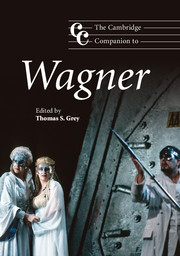Book contents
- Frontmatter
- PART I Biographical and historical contexts
- PART II Opera, music, drama
- 4 The “Romantic operas” and the turn to myth
- 5 Der Ring des Nibelungen: conception and interpretation
- 6 Leitmotif, temporality, and musical design in the Ring
- 7 Tristan und Isolde: essence and appearance
- 8 Performing Germany in Wagner's Die Meistersinger von Nürnberg
- 9 Parsifal: redemption and Kunstreligion
- PART III Ideas and ideology in the Gesamtkunstwerk
- PART IV After Wagner: influence and interpretation
- Notes
- Select bibliography
- Index
6 - Leitmotif, temporality, and musical design in the Ring
from PART II - Opera, music, drama
Published online by Cambridge University Press: 28 September 2011
- Frontmatter
- PART I Biographical and historical contexts
- PART II Opera, music, drama
- 4 The “Romantic operas” and the turn to myth
- 5 Der Ring des Nibelungen: conception and interpretation
- 6 Leitmotif, temporality, and musical design in the Ring
- 7 Tristan und Isolde: essence and appearance
- 8 Performing Germany in Wagner's Die Meistersinger von Nürnberg
- 9 Parsifal: redemption and Kunstreligion
- PART III Ideas and ideology in the Gesamtkunstwerk
- PART IV After Wagner: influence and interpretation
- Notes
- Select bibliography
- Index
Summary
New paths
In the first years of the nineteenth century, Ludwig van Beethoven famously announced to a friend, the violinist Wenzel Krumpholz, that he intended to embark on an entirely “new path.” Half a century later, in 1853, Robert Schumann proclaimed the advent of the young Johannes Brahms in the same terms – Neue Bahnen, new paths – in a valedictory feature of sorts in the progressive musical journal he himself had founded, the Neue Zeitschrift für Musik. This was a deliberate provocation, since the journal's new editor, Franz Brendel, was currently championing the radical theories of Richard Wagner, which provided much better fodder for journalistic debate than did the mostly unpublished works of a quiet twenty-year-old pianist. Beethoven's earlier “new path” gradually became apparent in works like the Eroica Symphony, while the novelty of Brahms's voice was much slower to be heard by the larger public. But probably the most emphatic decision made by any composer to chart a whole new course was that made by Wagner, at precisely the time of Schumann's tribute to Brahms. Indeed, Wagner himself later spoke of the “new path,” or neue Bahn, he entered in Das Rheingold.
- Type
- Chapter
- Information
- The Cambridge Companion to Wagner , pp. 85 - 114Publisher: Cambridge University PressPrint publication year: 2008
- 5
- Cited by



